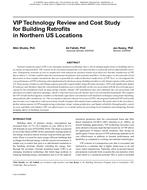Description
Vacuum insulation panel (VIP) is an emerging insulation technology that is slowly finding applications in buildings due to its energy saving potential. VIP consists of an evacuated nanoporous core material that is sealed off with an impermeable enclosure. Nanoporous structure of core in conjunction with reduced air pressure results in an ultra-low thermal conductivity of VIP that is almost 5–10 times smaller than the conventional insulations such as foams and fibers. In this paper, we first provide a brief discussion on heat transfer mechanisms that are responsible for reduced thermal conductivity of VIP. Next, we investigated the cost performance ofVIP technology when implemented in the deep energy building retrofits in cold climate regions of the northern US. Deep energy retrofits in cold climate regions generally require higher target R-value envelopes.VIPs with significantly higher R-value per unit thickness than the conventional insulations save considerably on the cost associated with the loss of living space caused by the installation itself. In deep energy retrofits, thinner VIP installations may also eliminate the cost associated with alteration of window and door openings, which is otherwise necessary for thicker layers of conventional insulations.We compare the VIP retrofit method against a number of thermally equivalent conventional wall insulation techniques using foam sheathing, sprayed foam, fiber insulations, etc.The cost analysis indicates that for lower priced VIPs, the proposed method ofVIP wall retrofit may become cost competitive with current deep retrofit strategies that employ foam insulations.We predict that in the near future, further advancements in VIP manufacturing technology, larger volume production, and higher reliability through quality control of cores and films will enhance VIP cost effectiveness as a retrofit option for providing local insulation and mitigating thermal bridging effects in building envelopes.
Presented at Thermal Performance of Exterior Envelopes of Whole Buildings XII, December 2013
Citation: Thermal Performance of Exterior Envelopes of Whole Buildings XII
Product Details
- Published:
- 2013
- Number of Pages:
- 9
- File Size:
- 1 file , 710 KB
- Product Code(s):
- D-BldConf13-67
